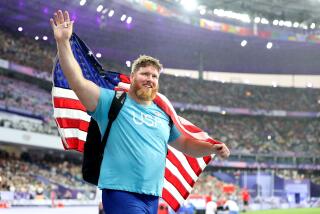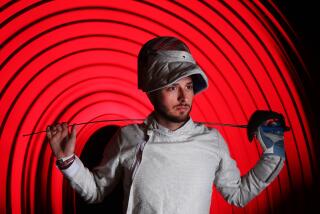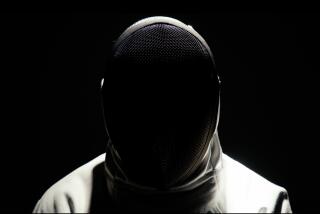Taking a Fling at the Olympics : Goode Tries to Show There’s Room at Top for Javelin Thrower Without Much Room
On Sundays this spring, stragglers from the 1 p.m. soccer game at Cal State Northridge and early arrivals for the 4 p.m. match often are startled by an unidentified flying javelin. Whistling out of the north, the thin aluminum shaft flashes between a couple of large trees, plummets downward and impales the earth at midfield. Moments later, a freckled giant in short pants lumbers over and extracts it.
That’s Kevin Goode, improvising as usual on the road to Seoul.
Goode, a 1983 CSUN graduate who is trying to make the U. S. team for the Summer Olympics, is facing the javelin thrower’s standard dilemma: inadequate training facilities. Javelin throwers need a lot of room. Standing on a football field, top throwers like Goode can release the javelin at the 20-yard line and reach the end zone 80 yards away.
It’s no wonder that other track and field athletes tend to head for the locker room when the javelins come out.
Javelin throwers, in fact, were becoming so good--343 feet, 10 inches is the world record--that they were running out of room at stadiums or being run out for endangering lives. So the rule makers changed the design of the javelin, redistributing the weight closer to the tip to bring it to earth more quickly. Even so, there aren’t many tracks with Olympic-quality javelin facilities.
Goode trains at CSUN’s track, which has a 400-meter oval covered in artificial material and a large grass infield. But it doesn’t have an Olympic-size 60-foot javelin runway. Goode needs one. Practicing his approach on grass would throw off his timing. So he paced off 60 feet on the track and found a configuration that enabled him to throw the javelin into an open field instead of Lindley Avenue or an apartment complex--he’s capable of throws exceeding 245 feet with the new javelin.
The configuration includes the soccer field, which lies to the south of the track. But the solution to the problem was not without its glitches. The soccer field is often in use, so Goode is limited to the hours he can practice without spearing a center forward. There are other abnormal conditions that confront Goode on his approach: a chain-link fence and large trees border the track and the soccer field. So Goode has to thread the javelin through an opening in the foliage to avoid skewering a branch. Then he has to pull up to avoid being waffled by the fence.
Fortunately, Goode is a good shot and only goes through this ordeal one day a week. The rest of the time he works on his throwing technique using the abbreviated five-step approach across the width of the track, which keeps the throws shorter and enables him to utilize the infield. His effortless throws sail 150 feet. When he puts the full force of his 250 pounds behind him, the 800-gram javelin soars nearly 230 feet. Needless to say, the field empties quickly when Goode unsheathes the lethal projectile that he hopes will propel him onto the Olympic team.
A throw of 245-9 at a meet in Santa Barbara ranked Goode 15th in the United States last year and qualified him for the Olympic Trials, which take place July 15-16 in Indianapolis. A throw of 260 feet probably would qualify him for a berth on the Olympic team.
Unlike sprinters and harmonica players, javelin throwers, pole vaulters and tuba players have to endure hardship and inconvenience--Goode’s 1984 Camaro hatchback, for example, has only enough room for him and the 8-foot-6 javelin. But Goode is in an especially tight squeeze, even for a javelin thrower. He’s unsponsored, which means he isn’t subsidized like some Olympic hopefuls who work 20 hours a week for a big corporation and get paid for 40.
To get himself in a position to train seven days a week, Goode had to quit a good-paying job to take a graduate assistant position with CSUN track Coach Don Strametz last year.
So Goode, four years out of college, was back going to class two nights a week to fulfill requirements for his master’s in physical education. To survive in a minimal way, he works three nights a week until 2 a.m. as a doorman-bouncer at a restaurant in Northridge. Until this month, he had been driving a truck five mornings a week since last summer.
And from 3 to 5 every afternoon during the week, he coaches Matador athletes in the field events. Shotput practice comes first, the javelin last. Goode stands to the side, watching form. “No, no, no,” he says to a shotputter. “You’re way stretched out. Your base is too big.” In an idle moment, Goode will also get in a little work, doing plyometrics--a throwing exercise with a heavy rubber ball.
Next year, Goode gets his master’s. He wants to be a college coach, which pleases Strametz. “Kevin works well with people,” he says, “and technically he knows what he’s doing.”
After the CSUN track team leaves the field, Goode fits in two hours of javelin practice before going off to class or to work. “I’m training harder now than when I was in school,” he says, “and that’s hard to believe. But if I couldn’t train while I was coaching, I don’t know what I’d do.”
The daily grind might get to some people but not to Goode. He welcomes it.
“I’m happier now than I’ve ever been,” he says. “I’m doing what I want to do.”
But it took Goode a long time to figure out that he wanted to be involved in athletics. A two-year starter for CSUN at offensive guard in football and a Division II All-American in three track events, Goode discovered after graduation that 9-to-5 was not for him. He was working in his father’s computer-parts business in his hometown of San Jose and “couldn’t handle being behind a desk.”
His javelin throwing was going nowhere. He couldn’t train effectively because of the job and his continuing discontent. Motivation flagging, he would enter track meets and ask himself, “What am I doing here?” His throws didn’t exceed 220 feet. In 1984 he hurt his knee. Then, in a cruel twist, his father’s business was sold and Goode was laid off. He got a job in a stockroom, sometimes working 70 hours a week, which cut him off from the javelin. He was miserable.
“Two years ago, I asked myself if I wouldn’t be happier back in athletics and throwing again,” says Goode, who was 27 then. “So I got up enough nerve and quit and then I went back to CSUN. Thankfully, I didn’t wait until it was too late.”
Goode excelled in four weight events as an undergrad at CSUN. He appears in the Matadors’ all-time list in the javelin (5th), hammer (3rd), discus (10th) and shotput (8th). Players on rival track teams, he says, called him jack-of-all-trades, master of none. He never devoted all his energy to one event until after college, when he decided to concentrate on the javelin because “I threw it the farthest.”
Because of injuries, Goode has only just recently been able to put together three consecutive years of training. Last year, his second on the comeback trail, produced dramatic results. His distances shot up to world class.
Goode has been training under a personal coach, Charlie DiMarco, who runs the Advantage Athletic track club in Northridge. DiMarco volunteers his time to analyze Goode’s technique, offer advice and establish a workout routine. Two months before the trials, he still had Goode on a weightlifting regime designed to strengthen his lower body. Goode also was doing standing broad jumps, hurdle hops and sprints in addition to pounding a sledge hammer against a tree.
But his daily food intake is not something DiMarco would suggest for anyone trying to build a body. Goode recognizes he has a problem. “Diet is the one thing I’m worst at,” he says. “Mainly because of lack of money or laziness. In the last two days, I had leftover macaroni and cheese for breakfast yesterday and nothing until a sandwich for lunch today.”
Malnutrition notwithstanding, size and weight are not that significant in throwing the javelin. Goode says technique is 80%. He points out that the holder of the new-style world record is Jan Zelezny of Czechoslovakia, who is only 6-1 1/2, 170 pounds. How much has the redesigned javelin affected competition? Zelezny’s 287-foot, 7-inch record with the new design is 56 feet less than the old record.
Like a golf swing, throwing the javelin has a thousand nuances. The technique has not changed in centuries. Armies of the ancient world knew the javelin under a different name, the spear. It developed militarily and was first recognized as a sport by the Greeks, who included javelin throwing in the first Olympics. But modern athletes have tools the Greeks lacked. Videotape has helped them isolate problems and break down the throw into the small details that affect flight.
“The javelin is the most aerodynamic of all throwing events,” DiMarco says. “Any slight error in technique will show up.”
Goode has learned that when he takes his approach, the javelin must be held precisely at the correct angle and let go at a slightly different angle. “The angle of attack is zero degrees,” he explains, “and the angle of release is 33%. You try to throw a line drive.”
He also knows that he has a flaw in his technique: winding up with his left knee flexed, which is apparently a bad habit to get into. But he and DiMarco are working to keep the leg down to stop it from drifting.
“Last year I tried to get Kevin to do the basics correctly and round out the rough edges,” DiMarco says. “If he had a problem, I got it under control. But he’s really coming along fast now. In the last month he’s made a lot of progress.”
While exercising his body, Goode is also going to give his mind a workout. He’s looking into mental exercises like hypnotism and visualization. Aside from watching tape of himself, Goode spends a lot of time in his rented house in Newhall analyzing javelin throwers at last year’s World Track and Field Championships.
Although Goode works hard on the field, he has a meandering pace that makes him appear to be moving in slow motion. “He has to be more aggressive in his workouts to make the Olympic team,” Strametz says. “Even now he’s still too laid back.” Goode smiles at the coach’s remark. “I’ve heard that before about me,” he says. “My father said the same thing.”
Goode scratches his head. “A lot of football coaches resented it when I took it easy in practice,” he says. “I’m a competitor, but as a rule, I am unaggressive.”
At practice one day recently, Goode is one of the last athletes on the track. The workout is almost over. Winding up like a fastball pitcher, his right arm stretched straight back, Goode takes five calculated steps and releases the javelin, which rockets skyward. He is being watched by DiMarco. “No, you got to get underneath it,” DiMarco shouts as Goode rambles out to retrieve the javelin.
The javelin was given to him by Dave Stephens, a friend and fellow thrower who trained with Goode in 1987. At the Mt. San Antonio Relays last year, Stephens hurled the new-style javelin 262 feet, fifth best in the nation. As a perk for being in the top 10, companies give him javelins and other equipment. Goode doesn’t get T-shirts. His Nikes have holes.
Goode returns with the javelin and prepares for another throw, concentrating on proper technique and getting his left foot down. The sun slips behind a low hill. Goode takes off in a loping stride and flings the javelin into the growing twilight. It flies more than 220 feet.
“Yes! That was good,” DiMarco says.
Goode smiles. Practice is over. “Let’s end it on that,” he says, and then trots off to find the javelin.
More to Read
Go beyond the scoreboard
Get the latest on L.A.'s teams in the daily Sports Report newsletter.
You may occasionally receive promotional content from the Los Angeles Times.






